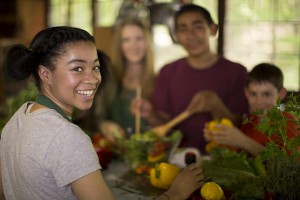by lauenc | Feb 5, 2024
Hunting, when approached responsibly, can be a rewarding and educational experience for young individuals. As a 4-H agent dedicated to fostering a love for the outdoors, I recognize the importance of instilling a strong foundation of ethics and safety when introducing youth to the world of hunting. To ensure a positive and educational introduction to this amazing tradition, several key considerations should be considered.
- Safety Training and Ethical Hunting Practices:
The Florida Fish and Wildlife Conservation Commission (FWC) offers comprehensive safety resources, emphasizing the importance of proper firearm handling, wildlife identification, and safe hunting practices. Educating young hunters about the critical role of safety protocols ensures a secure and enjoyable experience in the field. There are a variety of hunter safety courses available. Visit the Which Hunter Safety Course Is Right For You? | FWC (myfwc.com) webpage to find out what course to see what may work best for your family. If you have completed an online course and have a certificate, you can participate in the upcoming Field Day on November 18, 2023 at West Pittman Baptist Church in Holmes County. Visit the Hunter Safety Registration (site.com) webpage to register or find other courses in your area on a different date.
- First Shot Fundamentals:
Holmes County 4-H has been awarded several grants from the The National Rifle Association (NRA) Foundation. Our Holmes County 4-H Shooting Sports Program includes archery, rifle, and shotgun disciplines. Youth members learn “first shot fundamentals” that will translate to important life skills as they may choose to ultimately participate in hunting opportunities. Emphasizing the values of fair chase, respect for wildlife, and the importance of humane and responsible harvesting helps instill a deep appreciation for the natural world and ecosystem.
- Conservation Education:
Collaborating with 4-H programs that incorporate conservation education can help young hunters understand the vital role they play in wildlife conservation and habitat preservation. Teaching the principles of sustainable hunting and the importance of maintaining ecological balance contributes to the development of environmentally conscious and responsible hunters. This also includes ongoing education and research related to Chronic Wasting Disease (CWD) in Holmes County and the surrounding region to learn what we, as hunters, can do to help.
- Mentorship Programs:
The Florida Fish & Wildlife Conservation Commission often organizes mentorship programs that pair experienced hunters with newcomers. These programs, align with 4-H’s emphasis on positive youth development and foster a supportive learning environment. Mentors follow the guidance outlined in mentorship materials to provide hands-on training, impart valuable skills, and promote the development of strong ethical values in young hunters. Visit the Mentored Hunts Registration (site.com) webpage to find upcoming opportunities across the state of Florida.
- Legal Compliance and Regulations:
The Florida Fish and Wildlife Conservation Commission (FWC) provides up-to-date information on hunting regulations, licensing requirements, and seasonal restrictions. Educating youth about these regulations instills a sense of responsibility and legal compliance, contributing to the cultivation of law-abiding and conscientious hunters.
By integrating these considerations into the process of introducing youth to hunting, we can ensure that they develop not only a passion for the sport, but also a respect for wildlife and the natural world. Together, we can foster the next generation of responsible and ethical hunters who prioritize safety, conservation, and ethical hunting practices in their outdoor adventures. For more information about how your youth can get involved with Holmes County 4-H, visit the Holmes County 4-H (holmescounty4h.com) webpage.

Miah, daughter of the Holmes 4-H Agent, enjoys the opportunity to harvest her first deer at age 6.

Holmes County 4-H Agent, Chris Lauen, introduces his children to a Holmes County whitetail buck.
by Melanie Taylor | Jan 11, 2019

Be mindful and enjoy the moment.
Now that the busy holiday season is over, it’s a time to reflect on the past but prepare and refocus for the new year ahead. As we focus on the new year, it is always refreshing to have a clean slate. As the year begins to unfold, there are tips to help you manage your day-to-day stress levels. It begins with mindfulness.
What is mindfulness?
Mindfulness means paying attention in a particular way; on purpose, in the present moment, and non-judgmentally.” Dr. Jon Kabat-Zinn (1991)
Mindfulness is best thought of as a way of being rather than an activity Almost any activity can be carried out with mindful awareness.
Three Key Features of Mindful Awareness:
- Purpose – intentionally and purposefully directing your attention rather than letting it wander.
- Presence – being fully engaged with and attentive to the present moment. Thoughts about the past and future that arise are recognized simply as thoughts occurring in the present.
- Acceptance – being non-judgmental toward whatever arises in the moment. This means that sensations, thoughts, and emotions are not judged as good or bad, pleasant or unpleasant; they are simply noticed as “happening” and observed until they eventually pass (Naik, Harris and Forthun 2016).
Mindfulness is a mind-body practice that has been found to benefit both psychological and physical health. The primary psychological change that occurs during mindfulness practice is an increased awareness of thoughts, feelings, and sensations in the present moment. Over time, mindfulness practice can help you to become aware of the space between noticing experiences and reacting to them by letting you slow down and observe the processes of your mind (Black 2010).
The ultimate goal of mindfulness practice is for you to take advantage of this space so you can make more intentional decisions – to wake up from living life on autopilot, based on unproductive habits of mind
(Black 2010; Walach et al. 2007).
According to the American Psychological Association, some empirically supported benefits of mindfulness include the following (Davis & Hayes 2011):
Psychological Benefits
- Increased awareness of one’s mind
- Significantly reduced stress, anxiety, and negative emotions
- Increased control over ruminative thinking (a major cause and symptom of depression and anxiety)
- Increased mental flexibility and focus
- More working memory
- Decreased distracting thoughts
- Decreased emotional reactivity
- Increased capacity for intentional, responsive behaviors
- Increased empathy, compassion and conscientiousness of other’s emotions
Physiological Benefits
- Enhanced immune system functioning
- Increased brain density and neural integration in areas responsible for positive emotions, self-regulation, and long-term planning
- Lowered blood pressure
- Lowered levels of blood cortisol (a major stress hormone)
- Greater resistance to stress-related illnesses such as heart disease
Spiritual Benefits
- Increased self-insight and self-acceptance
- Increased acceptance of others
- Increased compassion and empathy
- Increased sense of morality, intuition, and courage to change
- Increased control over automatic behaviors
- Increased self-discipline
The question is, how many of us would like to benefit from mindfulness if it provides these positive benefits? All of us should strive to lower our stress level and enjoy our daily lives with a more positive attitude and more attentiveness. So, how can we incorporate this into our lives? The majority of this practice is about familiarizing yourself with what it feels like to be mindful, and getting better at “remembering” to maintain mindful awareness.
Experiment with creating your own mindfulness practices throughout your day. Being mindful of the sensation on the soles of your feet as you walk to your car or the taste and texture of your morning coffee can transform routine moments into deeply satisfying practices. However, having a ritualized and structured practice can be beneficial. To find out more about practicing mindfulness and how to incorporate a more structured practice in your life visit read Mindfulness: An Introduction.
Sources: Mindfulness: An Introduction. 2013, 2016. Retrieved from the UF/IFAS Extension Electronic Data Information System: https://edis.ifas.ufl.edu/fy1381. Publication #FCS2335
by Melanie Taylor | Dec 14, 2018

Aim to find JOY in this holiday season.
As the holiday season quickly approaches, many people are filled with extra holiday cheer and enthusiasm. Some are jolly but still overwhelmed with all of the activities, decorating, and shopping that needs to be completed. Then, there are those that find the holiday season as a reminder of things such as the death of a loved one, family feuds, divorce…the list goes on. If you are feeling this way, here are a few tips to make getting through the season a little bit easier.
- Feel your emotions – Many people want to suppress their sadness or anxiety, but this only makes it worse. We are all allowed to grieve, cry and feel mad at times. If you feel this way, let yourself feel your feelings. You will feel better once you have accepted and worked through the emotions. You also do not have to force yourself to feel happy just because it is the holiday season.
- Reach out to others – Instead of secluding yourself, spend time with others whether it’s at church, a community group or with family and friends. Spending time with others and socializing is good for the spirit.
- Volunteer – There are tons of volunteer opportunities during the holidays. Try something new and volunteer your time to a worthy cause. You’ll feel great about helping others and contributing to a cause.A national survey commissioned by UnitedHealth Group talked to 3,351 adults and found the majority of participants reported feeling mentally and physically healthier after a volunteer experience.
The research showed:
* 96% reported volunteering enriched their sense of purpose in life
* 94% of people said volunteering improved their mood
* 80% of them feel like they have control over their health
* 78% of them said volunteering lowered their stress levels
* 76% of people said volunteering has made them feel healthier
* About a quarter reported their volunteer work helped them manage a chronic illness by keeping them
active and taking their minds off of their own problems
* Volunteering improved their mood and self-esteem
- Be realistic – Realize that times and traditions change as families grow and age. Do not focus on things having to be the same every year. Be willing to accept changes, such as adult children may not be able to attend the family gathering, so utilize technology and talk through video conferencing, share pictures on email and/or Facebook. Find a way to make it work.
- Set aside differences for everyone’s sake. Aim to accept family and friends the way they are, even if they do not meet your expectations. Leave grievances at the door for the day and enjoy your family and friends. Share those grievances and talk at a more appropriate and private time. Also, remember they could be feeling the stress of the holiday too. So, be patient if someone is grouchy or sad as you celebrate. You may both be feeling the same way.
- Learn to say no – Be realistic in the number of activities you and your family can participate. Do not feel guilty because you cannot attend every party and event you are invited too. Graciously decline an invite and share that your schedule is booked, but thank them for thinking of you. A host does not expect that everyone will attend their parties.
- Take a breather as needed – If you start to feel overwhelmed with anxiety, anger or sadness take a few minutes to be alone. Take 15 minutes to spend in the quiet to reduce the stress and clear your mind. For example: listen to soothing music, do a few mindful breathing exercises to slow yourself down or read a book to temporarily escape the stress.
- Seek professional help as needed – there are times when the emotions are just too overwhelming to sort through on our own. If you continue to feel sad, anxious, angry, etc. there is absolutely no shame in seeking the help of a doctor or mental health professional. It will only help you work through your feelings with a non-bias person. Helping yourself feel better will improve your quality of life and those around you.
Learn to take care of yourself first. Learn your limitations and accept them. Don’t t let other’s expectations overwhelm you. Just remember when you start feeling extreme levels of emotions and/or stress, take a few deep breathes and remind yourself to relax and feel the moment. Be mindful of your surroundings and remind yourself of your many blessings even when going through difficult times. Make it your personal goal to feel your feelings and enjoy what you can about the holiday season whether it is the twinkling lights, time with friends and family, the food or any of the many special holiday traditions.
Striving for and maintaining a healthy lifestyle is an achievable goal and a National 4-H Council mission mandate for all of our 4-H members, families and volunteers. To learn more about healthy lifestyles and 4-H, find your local UF/IFAS Extension office.
Sources:
by Monica Brinkley | Feb 12, 2016

Making family meal time a priority can increase your children’s self esteem.
In a recent book entitled The Surprising Power of Family Meals, author Miriam Weinstein asks this question:
“What if I told you that there was a magic bullet-something that would improve the quality of your daily life, your children’s chances of success in the world, (and) your family’s health…? Something that is inexpensive, simple to produce, and within the reach of pretty much everyone? (Weinstein, 2005, p. 1)”
You guessed it, that magic bullet is the family meal! According to research, eating together as a family on a regular basis has some surprising effects. When sharing a meal together family bonds become stronger, children are better adjusted, family members eat more nutritional meals, they are less likely to be overweight, and they are less likely to abuse alcohol or other drugs. Given the positive benefits of eating together, why are more families not doing it?
It may come as a surprise to you that 71% of older children and teenagers consider talking/catching-up, and spending time with family members as the best part of family dinners. Family meals are a representation of the ethnic, cultural, or religious heritage of the family (Weinstein, 2005). A study found that children who knew a lot about their family history had a closer relationship to family members, higher self-esteem, and a great sense of control over their own lives (Duke, Fivush, Lazarus, & Bohanek, 2003).
With this in mind, why not make shared family meals a priority. Emphasize the importance of being together, not creating an elaborate meal that everyone will enjoy. Set regular meal times by writing them on the calendar. Let everyone know when dinner is served and when they must be home.
If the family is not used to eating together regularly, start small. At first, get used to eating together by scheduling family meals two or three days per week. Then, as the weeks progress, begin to have more and more regular meals.
Make family meals fun. Include children in the preparation of the meal and in the decision about what foods will be offered during the meal. Of course, parents have final say about what foods are prepared, but allowing the children to participate can create a fun environment.
- Keep a sense of humor while at the dinner table.
- Eliminate distractions, like TV, telephone, and cell phones.
- Limit conversations to positive or neutral topics.
- Be a good role model. Show children good etiquette and table manners.
Eating together as a family is more than just a meal, it is an opportunity for families to come together regularly in support of family unity. Although there is no guarantee that eating together as a family will resolve all family problems, it may provide the opportunity to make a fresh start. Do you have a passion for meal preparation or etiquette that you would like to share with the next generation? Consider becoming a 4-H Volunteer! Visit our website or contact your local UF IFAS Extension Office.
For the more information on this topics please visit the EDIA website at http://edis.ifas.ufl.edu, FCS8871.
Source Family Nutrition: The Truth about Family Meals, Larry Forthun

by Melanie Taylor | Dec 11, 2015
 The holidays are often filled with time-honored traditions that include some of our favorite meals and foods. As you celebrate, think of little changes you can make this holiday season to create healthier meals and active days. An added bonus, these small changes may help you to avoid those extra holiday pounds we all fear each year. Happy Cooking!
The holidays are often filled with time-honored traditions that include some of our favorite meals and foods. As you celebrate, think of little changes you can make this holiday season to create healthier meals and active days. An added bonus, these small changes may help you to avoid those extra holiday pounds we all fear each year. Happy Cooking!
In the Kitchen:
• For gravies or sauces — if you are making pan gravy, first skim the fat off pan drippings. For cream or white sauces, use fat-free (skim) milk and soft tub or liquid margarine.
• For dressings or stuffing — add low-sodium broth or pan drippings with the fat skimmed off instead of lard or butter. Use herbs and spices and a whole grain bread for added flavor.
• For biscuits — use vegetable oil instead of lard or butter and fat-free (skim) milk or 1 percent buttermilk instead of regular milk.
• For greens — use skin-free smoked turkey, liquid smoke, fat-free bacon bits, or low-fat bacon instead of fatty meats.
• For sweet potato pie — mash sweet potato with orange juice concentrate, nutmeg, vanilla, cinnamon, and only one egg. Leave out the butter.
• For cakes, cookies, quick breads, and pancakes — use egg whites or egg substitute instead of whole eggs. Two egg whites can be substituted in many recipes for one whole egg.
• Use unsweetened applesauce or mashed ripe bananas instead of butter.
• Try cutting the amount of sugar listed in recipes in half.
• Use spices to add flavor such as cinnamon, allspice, or nutmeg instead of salt.
• Try baked apples with cinnamon and a sprinkle of sugar instead of apple pie.
• Invite your guests to make their own parfait with colorful sliced fruit and low-fat yogurt.
For meats and poultry (chicken and turkey):
• Trim away all of the visible fat from meats and poultry before cooking.
• Take off poultry skin before eating.
• Broil, grill, roast, poach, or boil meat, poultry, or fish instead of frying.
• Drain off any fat that appears during cooking.
• Chill meat and poultry broth until fat becomes solid. Skim off fat before using the broth.
• Skip or limit the breading on meat, poultry, or fish. Breading adds fat and calories. It will also cause the food to soak up more fat during frying.
• Choose and prepare foods without high fat sauces or gravies.
When Shopping:
• Start with a lean choice.
• The leanest beef cuts include round steaks and roasts (round eye, top round, bottom round, round tip), top loin, top sirloin, and chuck shoulder and arm roasts.
• The leanest pork choices include pork loin, tenderloin, center loin, and ham.
• Boneless skinless chicken breasts and turkey cutlets are the leanest poultry choice.
Use the food label to help you choose
• Choose extra lean ground beef. The label should say at least “90% lean.” You may be able to find ground beef that is 93% or 95% lean.
• Processed meats such as hams, sausages, frankfurters, and luncheon or deli meats have added sodium. Check the ingredient and Nutrition Facts label to help limit sodium intake.
• Fresh chicken, turkey, and pork that have been enhanced with a salt-containing solution also have added sodium. Check the product label for statements such as “self-basting” or “contains up to __% of __.”
• Lower fat versions of many processed meats are available. Look on the Nutrition Facts label to choose products with less fat and saturated fat.
De-Saturate
• Use a nonstick pan with vegetable cooking oil spray or a small amount of liquid vegetable oil instead of lard, butter, shortening, or other fats that are solid at room temperature.
Enjoy the Food, Fun, Friends and Family!
Cheers to Good Health
• Quench your thirst with low-calorie options. Drink water with lemon or lime slices. Offer seltzer water with a splash of 100% fruit juice.
Be the Life of the Party
• Laugh, mingle, dance, and play games. Focus on fun and enjoy the company of others.
Give to Others
• Spend time providing foods or preparing meals for those who may need a little help. Give food to a local food bank or volunteer to serve meals at a shelter during the holiday season. Giving back is a great mood booster.
Make Exercise a Part of the Fun
• Make being active part of your holiday tradition. Have fun walking and talking with family and friends after a holiday meal. Give gifts that encourage others to practice healthy habits such as workout DVDs, running shoes, and reusable water bottles.
Enjoy the Leftovers
• Create delicious new meals with your leftovers. Add turkey to soups or salads. Use extra veggies in omelets, sandwiches, or stews. The possibilities are endless!
Be sure your family and friends enjoy the food and fun, but focus on the time together. Remember this season is all about the memories, not just the food. You will feel better and enjoy your holiday time with less worry if you focus on staying healthy this season.
Source: USDA United States Department of Agriculture – www.MyPlate.gov






